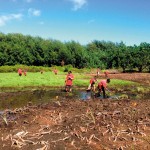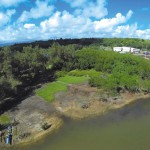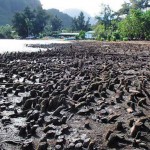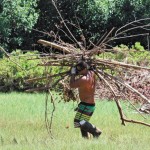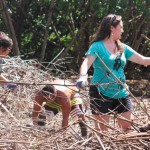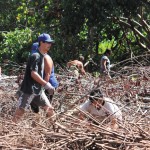Bringing Back A Beach
Old-timers recall the days when Niumalu Beach Park was a gem. Then the mangroves took over, slowly choking water and access. Today, old and young alike are working to make Niumalu a place worth visiting again
Niumalu Beach Park once was a wall of weeds, but thanks to Malama Huleia, it’s finally getting a makeover.
- Boy Scouts Troop 148 helps replant grass | Photo courtesy of Devi Berg
- An aerial shot of the Huleia watershed that has been cleared of mangrove Photo courtesy Joel Guy
- The remnants of mangrove
- Volunteers work to remove invasive species at Niumalu Beach Park
- Volunteers work to remove invasive species at Niumalu Beach Park
- Volunteers work to remove invasive species at Niumalu Beach Park
“Now the breeze flows through here,” says Jan Tenbruggencate, vice chairman of the organization’s steering committee, at the county park. “It hasn’t done that in probably 50 years.”
Volunteers began work to eradicate invasive species more than a year ago, and even though red mangrove is a particularly tough weed to tackle, there is already a noticeable improvement in the area.
“It’s much more attractive,” says Tenbruggencate. The Lihue park’s enhancement not only has allowed its patrons enjoy a better view, it also has helped fishermen gain easier access to the water.
“Because you can’t fish in the middle of a forest,” jokes Carl Berg, the organization’s chief scientist.
The next phase of Malama Huleia’s process includes not only moving on to clear weeds in a new section of the park, but also planting culturally significant species, such as kipukai and hala, that thrive there.
“The idea is to revitalize the area,” explains Berg. They hope to make the new clearing into a recreational spot, with a path that leads to the water and picnic tables nestled amid native milo trees. The long-term goal is to continue clearing weeds all the way up the river, which was once heavily used by the community but has since been “choked by the mangrove,” says Tenbruggencate.
The Lihue resident remembers when the river used to accommodate five outrigger canoes side-by-side.
“Some places you’re lucky to get two through now,” he says.
And before Nawiliwili harbor was dredged and filled several decades ago, the area had a sandy beach that stretched all the way to Kalapaki – once one of the largest bays in Hawaii. However, the natural flow of water in the area was impacted by construction and made worse by mangrove, which arrived some 70 to 80 years ago. By clearing the area, when the tide comes in, mud and plant debris wash out and sand is recovered.
Revitalization also is planned for the currently defunct Alekoko fish pond.
“It’s the best example in the state of a cultural resource,” says Berg of the historic site.
Also a Lihue resident, Berg has an attachment to the fish pond and has been attempting to restore it for a number of years. It was his neighbor and friend Steve Yee who initiated the inception of Malama Huleia, gathering community members who are familiar with the area, like Berg, to help.
Yee also has a fondness for the Huleia watershed, especially since he and Tenbruggencate are paddlers and members of Kaiola Canoe Club, which regularly traverses the Huleia River.
“We couldn’t help but notice that the mangrove is just taking over,” says Yee.
After conducting research into getting grants to clear invasive species, Yee applied for a federal grant from NOAA through Kaiola Canoe Club that is administered by Hawaii Community Foundation. The group has since received two one-year grants for 2013 and 2014.
There currently are seven volunteer steering-committee members as well as two project managers, Malia Chun and Buddy Keala.
“We’re all a team,” says Yee.
Helping foster community through teamwork is another Malama Huleia goal. Countless volunteers already have lent their time pulling weeds, and organizations such as the Rotary Club and Boy Scouts have assisted in the area’s restoration.
“It’s rewarding knowing that we’ve gotten so many people behind us,” says Yee.
Malama Huleia invites the public to celebrate its one-year anniversary Friday (Feb. 21) at 5 p.m. at Niumalu Beach Park. For more information, visit malamahuleia.org.

